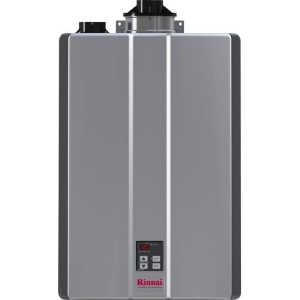- Home
- Electric Water Heaters
Electric Water Heaters: Type Review, Sizing and Buying Tips
Explore our comprehensive guide on electric water heaters, tailored for residential whole-house and point-of-use water heating.
In this review, we'll delve into the world of electric-powered water heaters, with a particular focus on tank-type and tankless units.
You'll gain insights into the inner workings of electric models, uncover their numerous advantages, and explore key components.
Additionally, you'll discover the leading manufacturers, receive valuable troubleshooting tips, find recommendations for the best models, and ultimately determine if they are a sound investment for your specific needs.
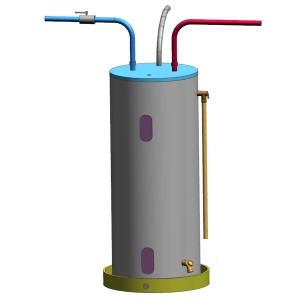 Electric water heater
Electric water heaterHighlights
Comparing electric vs. gas water heaters
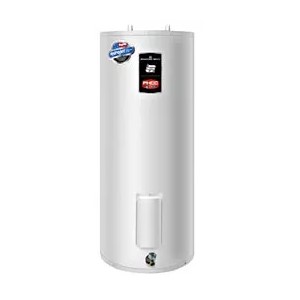 Electric water heater Electric water heater |
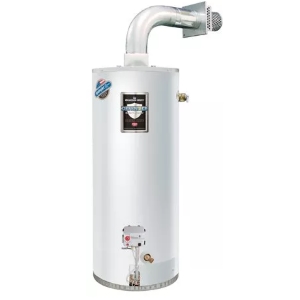 Gas water heater Gas water heater |
When it comes to providing hot water for your home, one of the fundamental decisions you'll face is whether to opt for an electric or gas water heater.
Both types have their own set of advantages and considerations, making the choice a crucial one that can impact your comfort and energy bills.
For some homeowners, electric water heaters can be considered "better" or more advantageous than other types of water heaters in certain situations, depending on your specific needs and circumstances.
Here are some reasons why electric water heaters are often preferred:
- Cost efficiency: Electric water heaters are generally cheaper to purchase initially, but they tend to cost more to operate compared to gas heaters.
- Installation and venting: Electric water heaters are relatively easy to install, especially in areas where natural gas lines are not readily available. You don't need to worry about gas connections or venting systems, making them a practical choice for a wide range of locations.
- Ease of use and maintenance: Electric models are simpler to use, service, and maintain.
- Safety: Electric units are considered safer as there is no risk of gas leaks or carbon monoxide emissions.
- Efficiency: Electric heaters are more energy-efficient than gas ones, as there is no heat loss through venting systems or pilot lights.
- Noise: Electric heating operates quietly.
- Indoor air quality: Electric models offer better indoor air quality since they produce no combustion byproducts or leaks.
- Fast heating: Gas heaters heat water faster and typically have shorter recovery times.
- Cost: Gas is often more affordable as a fuel source.
- Electricity independence: Gas models can continue to function even during power outages.
- Energy star certification: Some gas models are Energy Star approved, indicating their energy efficiency and environmental benefits.
- Availability: Electric water heaters are widely available, making it easier to find replacement parts and service technicians if needed.
How to size an electric water heater properly: Sizing tips
To correctly size an electric water heater and avoid getting one that's either too large or too small, consider the following tips:
- Determine your hot water needs: For tank-type heaters, determine the number of people in your household who will be using hot water. For tankless heaters, calculate the number of appliances you plan to run simultaneously and use the chart below to figure out how many gallons of water you'll need.
- Know the First-Hour Rating (FHR): Understand how much hot water is required during the peak usage hour.
- Consider temperature rise: Calculate the temperature difference between your desired hot water temperature and the temperature of the incoming groundwater.
- Common tank sizes: Tank-type heaters typically come in sizes of 40, 50, and 60 gallons. If you were satisfied with the performance of your previous unit, stick with the same size.
- Recommended tank sizes: For 2-3 people, a 40-gallon unit is suitable.For 4-5 people, opt for a 50-gallon unit. For households with more than five people, consider a 60- or even an 80-gallon unit.
- For tankless heaters: Determine the temperature rise (desired outgoing temperature minus incoming water temperature) and the hot water requirement for each application (e.g., shower, washing machine, dishwasher).
- Example for tankless sizing: If your groundwater temperature is 50°F and you want a hot water temperature of 140°F, and you plan to run a shower (2.0 GPM), washing machine (2.0 GPM), and dishwasher (2.0 GPM) simultaneously, look for a tankless unit that can provide 6 GPM with a temperature rise of 90°F (140-50).
- Hot water usage: Be aware of your hot water usage for various tasks. For example, a shower typically uses 2 gallons per minute, shaving 2 gallons, hands and face washing 4 gallons, food preparation 5 gallons, and an automatic dishwasher 14 gallons. Remember that you can use up to 70% of the available capacity. So, if you need 50 gallons of hot water, consider buying a 60-80-gallon unit.
These guidelines will help you choose the right-sized electric water heater to meet your specific needs, ensuring both efficiency and cost-effectiveness.
Buying tips: Features to look for
When purchasing an electric water heater, it's important to consider various features to ensure you select the right unit for your specific requirements. Here are some key features to look for:
- Tank size and capacity: Determine the appropriate tank size based on your household's hot water needs. Consider the number of people in your home and your peak hot water usage.
- Energy efficiency: Check the Energy Factor (EF) rating. Look for models with high energy efficiency ratings. Energy Star-certified heaters are a good choice as they can significantly reduce energy consumption and lower utility bills.
- High First-Hour Rating (FHR): Look for a water heater with a high FHR, indicating its ability to heat a significant volume of water per hour. This is especially crucial during peak usage hours.
- Quality glass lining: Opt for models with commercial-grade components, including high-quality glass lining that offers protection against corrosion. The best models often feature stainless steel tanks, like the Westinghouse 50-gal electric model.
- Self-cleaning system: Consider water heaters equipped with a self-cleaning system to reduce the likelihood of sediment buildup, which can lead to decreased performance and lower efficiency.
- Incoloy heating elements with dry-fire protection: Choose units with Incoloy heating elements, which are stainless steel elements protected by a control system to prevent burning out when the tank is not full of water during startup. Incoloy heating elements are known for their excellent corrosion resistance, strength, and resistance to oxidation, even in hard water and high-temperature conditions.
- Commercial-grade or powered anode: For anode protection, powered anodes are preferable to sacrificial ones. They have a longer lifespan and require less maintenance.
- Brass draining valve: Look for models equipped with brass draining valves, as opposed to plastic ones found in economy models. Brass valves are more durable and reliable.
- Electronic user interface: Advanced models typically include an electronic user interface, a diagnostic system, and a temperature display for user convenience.
- Wi-Fi capability: Consider water heaters with Wi-Fi capability, allowing you to control the water temperature remotely for added convenience and energy savings.
- Availability of replacement parts: Ensure that replacement parts and service for the selected model are readily available in your area. This can save you time and money in the event of repairs.
- Environmental impact: Consider the environmental impact of your choice. Some water heaters are more eco-friendly than others, with features like low emissions and reduced energy consumption.
- Warranty: The best models often come with longer warranties, such as 12 years, providing you with peace of mind and confidence in the product's durability and performance.
- Budget: Determine your budget and compare it to the cost of the water heater, installation, and potential long-term energy savings. Balance your needs and financial constraints.
Things to consider - Requirements
The specific requirements for an electric water heater can vary depending on factors like the size of the unit and your local building codes. However, here are some typical numbers and specifications to consider:
- Voltage: Electric water heaters in residential settings often require a voltage of 240 volts.
- Amperage: The amperage or current rating for electric water heaters can range from 15 amps for smaller units to 30 amps or more for larger models. For example, a 40-gallon electric water heater might have a 4500-watt heating element and require a 240-volt, 20-amp circuit.
- Circuit breaker: You will typically need a dedicated circuit with a circuit breaker of appropriate amperage to match the water heater's requirements. For example, a 4500-watt, 240-volt water heater might require a 20-amp circuit breaker.
- Wire gauge: The wire size or gauge should match the amperage and voltage requirements. For a 20-amp circuit, you might use 12-gauge wire, but for a 30-amp circuit, you'd likely need 10-gauge wire.
- Water heater size: The size of the water heater tank is specified in gallons. Common residential sizes include 40, 50, or 80 gallons, with larger or smaller options available.
- Recovery rate: The recovery rate is the amount of water the heater can heat in an hour. It's typically specified in gallons per hour (GPH) and can range from around 20 GPH for smaller units to 60 GPH or more for larger ones.
- Temperature setting: Electric water heaters are typically set to a default temperature of around 120°F (49°C). However, you can adjust this to suit your preferences while maintaining safety.
- Pressure relief valve: The pressure relief valve should be set to release pressure if it exceeds the safe limit, often around 150 psi.
- Clearances: Ensure proper clearances around the water heater to provide safe access for maintenance and service. This is typically a few inches or more, depending on the model.
Electric water heater types
Electric water heaters come in various types, and choosing the right one can make a big difference in your daily life. It's like picking the perfect tool for a job.
Each type brings with it its own array of advantages and considerations, enabling consumers to make informed decisions that align with their specific heating requirements, budgets, and environmental objectives.
So, whether you're seeking an energy-efficient marvel, a space-saving solution, or a sustainable heating option, understanding these electric water heater types will pave the way for a well-informed choice, ensuring a warm and comfortable experience in your daily life.
Here's an overview of the common types of electric water heaters:
Electric tank type
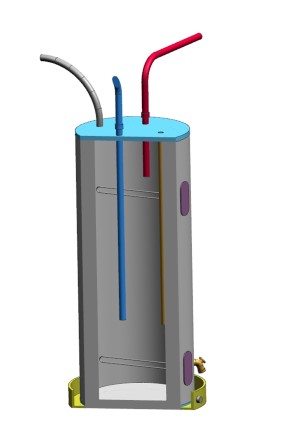 Electric water heater
Electric water heaterElectric hot water heaters with the storage tank are the most popular type in the US and Canada. They are big, heavy, but reliable, utilizing proven technology. There are various types such as the conventional tall, medium or short, Lowboy, Tabletop, POU (point-of-use), where the models with a 50-gallon capacity are the most popular.
Users and plumbers love this type because they are simple, easy to operate, service, and troubleshoot. There is no venting required, they are cheap and can be used in most homes.
Popular manufacturers
|
|
Main components
The following components are used in most of the traditional type heaters:
- Storage tank with the ceramic lining
- Insulation
- Heating elements
- Thermostat
- Dip tube
- Anode rod
- TPR valve
- Drain valve
- Heat traps
How does it work?
Conventional electric water heaters utilize one or two heating elements (lower and upper) for water heating and corresponding thermostats for temperature control. As the heating elements are fully immersed, they can transfer more than 90% (even 99%) of heat.
Regardless of whether the tap is open or not, water inside the tank is continuously heated and maintained at the preset temperature.
Cold water from the home plumbing fills the tank through the dip tube, which is submerged almost to the bottom of the tank.
One of the heating elements is turned on when the thermostat senses that the water temperature is below the set value. Each heating element carries its own thermostat, which is mounted against the tank surface.
When the hot water tap is opened, hot water from the top of the tank is drawn, and as the water level drops, fresh but cold water enters the tank. The lower temperature triggers the heating elements to heat the water back to the set value. Once it reaches the set temperature, the thermostat turns off the heating element, waiting for another demand.
Electric hot water heaters are equipped with safety features as well, such as a high limit switch that prevents water from boiling or exceeding the temperature set on the thermostat, particularly if the thermostat fails.
Electric tankless type
 Electric tankless water heater
Electric tankless water heaterTankless electric water heaters are small, wall-hanging units that provide hot water only when there is demand. These heaters are often installed under the sink and used at the point of service, delivering hot water in an endless and continuous supply.
Because they heat water as it moves through the heat exchanger, there is no standby heat loss. With on-demand heating, water is always fresh, delivered quickly, and offers substantial energy savings.
Popular manufacturers
- Rheem
- Bosch
- EcoSmart
- Eemax
- Stiebel Eltron
- Titan
Main components
- Inlet and outlet pipes
- Flow sensor
- Heating element(s)
- Temperature sensor
- Control panel
- Circuit board (Microprocessor)
- Safety features (e.g., high-temperature cutoff)
- Heat exchanger
- Housing or casing
- Pressure relief valve
How does it work?
Electric water heaters with tankless technology heat water on demand. They don't utilize the tank, but the heat exchanger where water is heated. They are small, compact and lightweight, often installed on the wall.
Tankless models produce endless hot water and only when there is demand. A great example is Stiebel Eltron and its popular model Tempra, DHC, and DHC-E models.
When there is a "call" for hot water (the tap is open), cold water passes over the heating element and is heated instantaneously. Based on its power, the tankless water heater can supply one or more fixtures at the same time while working as the point-of-use or whole-house heater.
Heat pumps
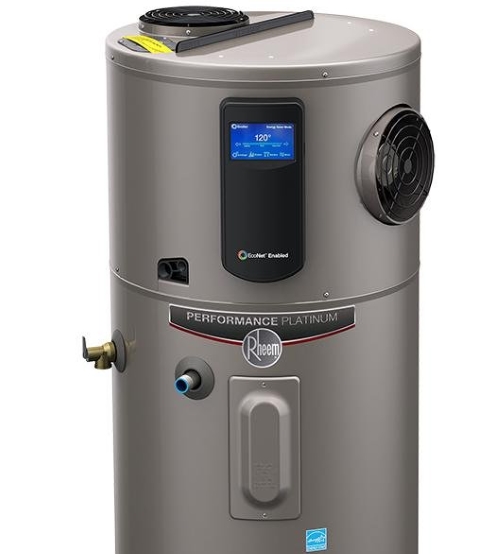 Rheem hybrid (heat pump)
Rheem hybrid (heat pump)Heat pumps or hybrid heaters are ultra-efficient electric heaters that provide high energy factors of two or more. They are Energy Star compliant and eligible for tax credits and rebates. Heat pumps are ideal for attic, garage, and basement installations, making them a favorite choice for homeowners who want to adopt environmentally friendly heating solutions.
Popular manufacturers
- Rheem
- A.O. Smith
- GE
- Stiebel Eltron
- Ecosmart
- Bosch
- Bradford White
- State Water Heaters
Main components
- Heat pump compressor
- Fan
- Refrigerant lines
- Condensate drain
- Heat exchanger
- Storage tank
- Electric heating element (backup)
- Control panel
- Circuit board (microprocessor)
- Inlet and outlet pipes
- Temperature and pressure relief valve
- Anode rod
- Insulation
Note: See here how electric water heaters work
How does it work?
An electric heat pump water heater operates by using electricity to transfer heat from the surrounding air into the water stored in its tank.
It starts with a heat pump unit, which contains a refrigerant fluid capable of absorbing heat even at low temperatures. This unit draws in warm air from the environment, heats the refrigerant, and circulates it through a coil inside the water tank, transferring heat to the water.
The process repeats as needed. Some models have an electric heating element for backup during high-demand or cold conditions.
This efficient system delivers hot water efficiently and is especially effective in moderate to warm climates, offering energy savings compared to traditional electric water heaters.
Conclusion
When searching for the best electric water heaters, look for high-efficiency models. These units save energy, heat water quickly, but may not be Energy Star compliant. None of the electric tank-type and tankless-type heaters are eligible for government grants unless they utilize heat pump technology. Heat pumps are the only electrical appliances that are Energy Star approved.
If you prefer proven technology and a traditional, bulky water heater, and your family has 4-5 members, go with the 50-60-gallon unit. This type will be sufficient to deliver hot water for every application in your home. Our recommendation is the Marathon model.
If your home lacks space, and you would like to have an endless supply of hot water that is heated on-demand only, go with the tankless option. Tempra and EcoSmart are good choices.
Tankless units never run out of hot water, as long as you have an electric connection. They conserve energy and water because you don't have to wait for the heater to heat up. They are convenient to use, easy to install, very safe, and also cost-effective.
Related
- Home
- Electric Water Heaters
